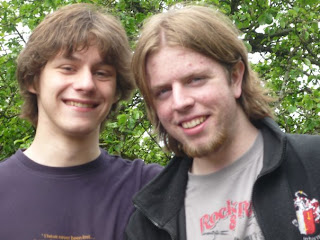Classical mechanics gives us two things, waves and particles. Particles are the touchy feely massy stuff that has momentum and displacement and all that lovely stuff, but generally is, and remains as is. Light is not that. Light is a wave, and can be diffracted, deflected and generally interfered with. I may have understated the complexity somewhat but that doesn't really matter, because as any A level physics student can tell you, that ain't quite the case, is it?
In 1801, Thomas Young sought to answer the question as to what light really was. He did so by developing one of the most boring experiments ever thrust upon teenagers the world over that involved lasers, or more likely, a filament light bulb shone through a slit. Given that this is 1801, I think we can make a pretty sound wager as to which we're talking about here. The set up was thus: Light would be shone through two slits, and the pattern on a screen beyond the slits would be recorded. If light was made up of particles, the pattern would be a bell curve of intensity. If light was a wave, a diffraction pattern would appear.
As it turned out, Young found the second pattern. so it was settled. Light was a wave. Decades later, a guy called Maxwell would formulate his wave equation from which could be determined the speed of light; a nippy 3x10
8 ms
-1.
I mentioned before that around the turn of the century, there was this problem going around regarding Black bodies and the light radiated from them. If you applied classical physics, or Maxwell's equation it come out as nonsense at large frequencies. It took Max Planck receiving a bunch of experimental data to get things going. He came up with the idea that light was made up of little packages of energy, or quanta.
Like many great, and even more awful theories, this wasn't taken particularly seriously at first, because let's face it, for all our talk of free thinking and empiricism, there are some physicists who are horribly stuck in their ways. Planck did nonetheless have his supporters in this particular idea. Einstein used it to great effect with his work on the photoelectric effect.
In short, this involved firing electrons between an anode and cathode, but making it somewhat difficult for the electron to reach the anode, though messing with the charges. It was supposed that if you increased the intensity of a light source aimed at the cathode the electrons would drink in the rarefied energy of the waves and have an easier time of it. This proved not to be the case. Indeed, the energy of the electrons seemed to be entirely independent of the intensity.
So, Einstein thought, if this Planck fellow is right, what does that mean? If we're firing individual particles, by increasing the intensity we're just firing more particles of the same energy. However if we were to increase the frequency, these little wave packets get more energy, and at some specific energy value the electrons hit by this energy would have enough to escape the surface of the cathode.
10 years later, a guy called Millikan would actually experimentally verify this, earning Einstein a Nobel prize.
So, light is made of little bundles of energy. That's nice. Can you smash other things with it? What a curiously violent question, imagined audience member. But yes, as it turns out you can.
Robert Holly Compton, the most amazingly named man ever to sport a toothbrush moustache observed what happened when you fire X-rays at electrons. Modelling x-rays as waves, one would expect the wave to just travel through the electron, moving it a little, like some twat reading his £129 Kindle in a pool.
 |
| "I'm not even reading it, this one is just to keep the sun out of my eyes." |
Instead what we find is the electron moves as if something has collided with it, while there now exists a wave with a longer wavelength than the one previous. Compton, following on from Einstein by adopting Planck's "light is quantised" theory, worked out that what was happening was the photon would collide with the electron, give it some energy, while of course losing that same energy. This would result in a moving electron and a lower energy photon, moving at an angle to each other because conservation of momentum.
So there we have it. Hard proof of that wave exhibit particle-like properties. Because fuck you I won't do what you tell me.








